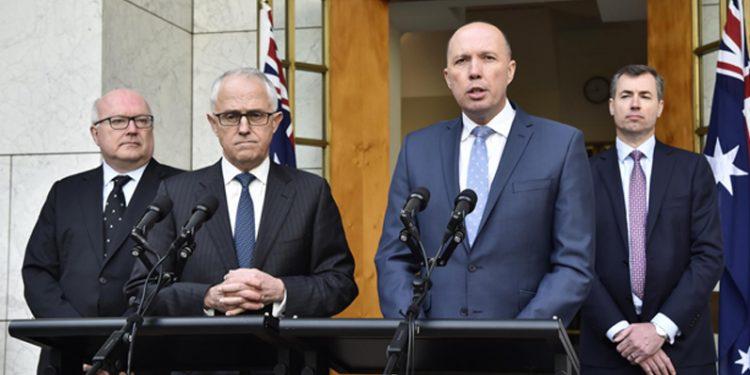
The public history of Australia’s intelligence community involves isolated moments of creation by political leaders and long periods of silence behind the secrecy curtain.
The public way stations in the history—in which the agencies were weighed and judged—were when reviews or inquiries lifted the curtain.
Big moments of creation were Prime Minister Ben Chifley’s establishment of the Australian Security Intelligence Organisation in 1949 and Malcolm Turnbull’s raising of the home affairs portfolio in 2017.
For the curtain-ups, see:
- the intelligence inquiries Justice Robert Hope did for three different Oz prime ministers in the 1970s and 1980s
- Philip Flood’s 2004 inquiry into Oz intelligence agencies
- Ric Smith’s 2008 review of homeland and border security
- the 2011 Cornall–Black review (the weakest effort in the set)
- the 2017 independent intelligence review by Michael L’Estrange and Stephen Merchant
- and soon an unclassified version of Dennis Richardson’s review of the legal framework of the intelligence community, due for release this year.
Two new books—a political memoir and a biography—give accounts of the politics of creation and the way inquiries have shifted and modelled the intelligence community.
Malcolm Turnbull’s A bigger picture offers a chapter with the title, ‘Matters of trust: reforming intelligence and home affairs’. And Peter Edwards does excellent history and fine biography with Law, politics and intelligence: A life of Robert Hope.
The Turnbull intelligence chapter is a curious five-page effort covering his 2017 announcement of ‘the most significant reform of Australia’s national intelligence and domestic security arrangements—and their oversight—in more than forty years’.
The changes had two separate elements that were brought together at the moment of Turnbull construction: one part was a curtain-up review effort, the other a sweeping act of political creation.
On the same day, Turnbull acted on the meticulous work of the L’Estrange–Merchant review while announcing his own creation (one the review didn’t recommend): the new super-portfolio, home affairs.
’Twas a strange mix, a classic Canberra example of the good and not so good of policymaking.
The Turnbull account of the birth of home affairs is policy framed by personalities and driven by politics. (I refer you to time-tested rules for understanding how politicians navigate Canberra: ‘It’s always personal’ and ‘There’s always a deal’.)
In the Turnbull telling, for many years there’d been a proposal to bring all the ‘domestic national security agencies together in one super-department, modelled on the UK’s Home Office’.
With that dusting of policy, Turnbull turns to the personalities. His predecessor as PM, Tony Abbott, initially supported the home affairs idea after the 2013 election, when it was being pushed by an up-and-coming minister called Scott Morrison. Abbott ‘then backed away from it, perhaps not wanting to give Morrison a bigger platform than he already had’.
In Turnbull’s case, the up-and-comer who’d head the new ministry was Peter Dutton. Other ministers expressed doubts about Dutton’s capacity for the expanded job, Turnbull writes, but the significant warning from colleagues was that ‘Dutton was after my job’.
The warnings ‘turned out to be right’, but Turnbull ‘had credited Dutton with enough common sense and self-awareness to realise that whatever our problems were, he was certainly not the solution’.
Despite the ‘horrified’ reaction of the agencies moving into the mega-portfolio and the political danger of giving Dutton ‘a position of enormous responsibility’, Turnbull created the Department of Home Affairs.
Note that half the chapter on reforming the intelligence community is actually a discussion of personality and political positioning. Turnbull’s verdict is that views may differ on whether he overestimated Dutton’s competence, ‘but certainly I misjudged his character’.
Malcolm Turnbull gave Peter Dutton a wonderful bone; it didn’t prevent the eventual fatal bite on Turnbull’s leadership.
Many Canberra truths are on offer. One is that prime ministers and ministers come and go, but the agencies they create endure and evolve.
From that reality, turn to Edwards’s account of the royal commissions and inquiries of Robert Hope. More than any other individual, Hope shaped the structures, operations and doctrines of Oz intelligence agencies. Turnbull gave the Hope model a mighty shake, but much from the judge endures.
Hope contributed to a distinct Australian construct you can see expressed in the buildings in Canberra’s parliamentary triangle; here’s a stroll from Parliament House down King’s Avenue, guided by Hope’s spirit.
As with many Oz intelligence practitioners, Edwards stresses the importance of Hope’s separation model—separating assessment from collection and policy.
The tension in the model is between contestability and coordination. Tribalism contends with groupthink. Canberra is a small town with strong tribes, and Edwards comments that the judge from Sydney sometimes underestimated that tribalism.
For a taste of the book, here’s Peter Edwards on Hope’s personality, the origins of his three inquiries, the principles of the Hope model and its future.
Edwards believes Hope’s model is challenged by Turnbull’s act of creation. That view is given glancing support by Turnbull’s final paragraph on his ‘historic’ changes: ‘[P]ublic sector reforms are a bit like business plans—the mediocre business plan well executed will always beat the brilliant business plan poorly executed.’
To see how well Turnbull’s creation is operating, Edwards says it’s time for another royal commission into Oz intelligence with ‘far-reaching and open-ended terms of reference’. Here are 11 questions Edwards thinks the commission should answer.
And here’s my interview with Peter Edwards on the need for another curtain-up effort on Oz intelligence.